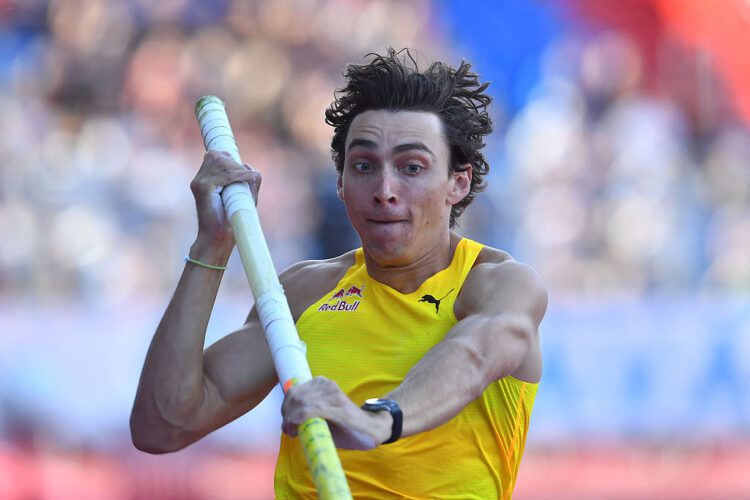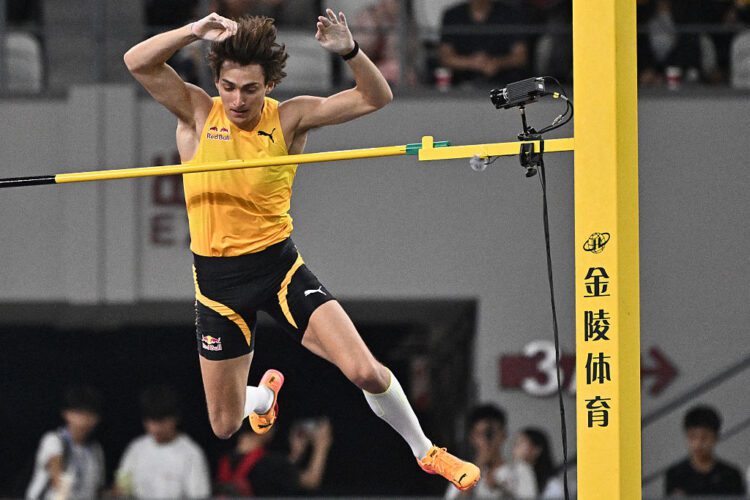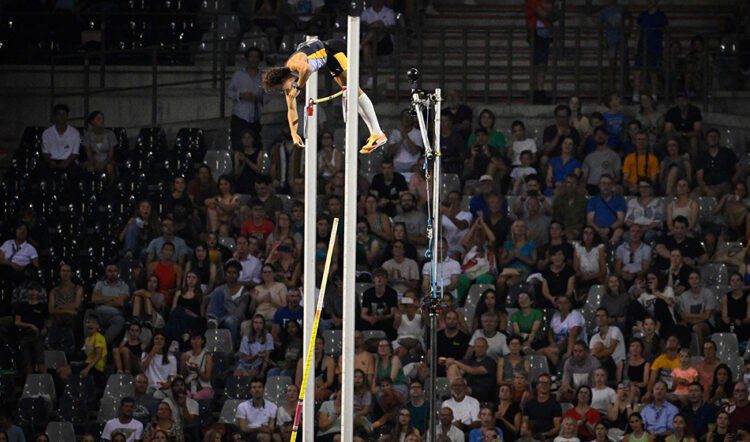His leap of 6.28m in Stockholm represented world document No.12 up to now. Cathal Dennehy delves into the tactic behind the a number of Olympic, world and European champion’s extraordinary rise
Lengthy earlier than the Olympic golds, world titles and world data, Mondo Duplantis was a pupil of his sport – one with an insatiable urge for food for enchancment. If he wasn’t on the pole vault runway that his dad constructed of their again yard in Lafayette, Louisiana, he was usually fascinated by it, conjuring up methods to hoist his physique ever increased.
“I daydreamed about it at college on a regular basis, about after I was going to get house and leap,” he says. “I really feel like, from a reasonably early age, I discovered that is what I used to be going to do.”
Duplantis cleared world age bests yearly between seven and 12, all of which nonetheless stand, and his twelfth senior world document on the current Stockholm Diamond League showcased once more that he’s an entire outlier. However Duplantis can also be one thing else – an innovator.
It’s 10 years since he exploded on the worldwide stage, successful the world under-18 title in Cali, Colombia aged simply 15, and far has been mentioned and written about him since as his star went supernova. However not a lot of it has examined precisely what he does to leap this excessive, given the technical trivialities of his occasion are sometimes incomprehensible to those that’ve by no means tried it.
To realize a greater understanding, AW spoke to Duplantis and to Mitch Krier, the long-time coach and husband of Greek star Katerina Stefanidi, the 2016 Olympic gold medallist and 2017 world champion.
Most pole vaulters might be grouped into certainly one of two leaping types: the Russian mannequin or French mannequin. The previous is most related to Vitaly Petrov, who coached Ukrainian Sergey Bubka and lots of different champions akin to Russia’s Yelena Isinbayeva and Brazil’s Fabiana Murer.

As a child, Duplantis studied all of the greats, then took what he noticed out into his again yard. “I attempted to mimic lots of jumpers,” he says. “I attempted leaping like Bubka, I attempted leaping like Renaud [Lavillenie], like Jean Galfione, lots of French guys – all of the folks I would see on YouTube. It simply type of fashioned into what labored finest for me.”
The Bubka/Petrov technique entails driving the knee excessive after take-off and protecting the palms nearer collectively on the pole however, having tried that in his youth, Duplantis felt it wasn’t proper for him.
“The best way that Bubka crops the pole and takes off and drives his proper knee, it by no means actually linked effectively with me – it wasn’t fluid,” he says. “So I type of discovered extra my very own method of doing it and connecting with the leap.” His present method is a “slightly bit of varied folks”.
“I do leap very in another way than Bubka. He was additionally fairly quick however he had his fingers tremendous shallow on [the pole]. The best way we take off the bottom and the best way we use our legs via the leap is completely totally different – the movement. He drives his knee and I fully drop it and go into like a ball. ‘Tuck and shoot’, we are saying.”

Krier has coached pole vault for 18 years, 10 of them as knowledgeable, and he says Duplantis’ fashion is “closest to the French”. One other distinction he sees between Duplantis and Bubka? How they set off down the runway.
“The Russians are extra about making an attempt to arrange this tall, excessive posture,” says Krier. “[Duplantis] is popping out accelerating from the beginning, however he’s in a position to maintain on and proceed to speed up, which is the superb half. There are folks that run onerous out of the again, however lots of them die off on the finish. He continues.”
Approaching take-off, Duplantis does one thing uncommon for vaulters, no matter their favoured methodology. He drops the pole early, permitting it to contact the runway earlier than it enters the field. Krier says the standard strategy was “all the time making an attempt to drop it on the very finish and time that up”, so why does Duplantis go in opposition to the grain?
“They’re discovering it is perhaps inflicting much less reverberation within the pole when it hits the bottom first,” says Krier. “He creates a full new vibration whereas, earlier than, the pole is vibrating a lot because it hits the field that these two forces can act in opposition to one another.”
Nevertheless, it comes with a danger.
“Plenty of the containers aren’t essentially flush with the monitor the place that edge meets,” says Krier. “So studying to try this could be onerous to show, for somebody to maintain it on the bottom and never let it pop over the field when it hits that entrance lip. Or when it hits the bottom, it might bounce again off the bottom and create all types of [issues].”

But it surely additionally comes with a reward.
“The quantity of stress he places into the bottom with that drop is extraordinary, to maintain the stress of the pole excellent on the bottom,” says Krier. “I don’t understand how you’d coach that.”
As for the strategy on take-off, Krier says: “The Russians appeared extra to get the highest of the pole to roll as excessive and as quick because it might. They’re making an attempt to take all the things as excessive up as they will to get the highest of the pole to maneuver quick, whereas the French or Mondo are taking benefit extra of the pole bend and their physique’s skill to play with that storage and elasticity. [Mondo] drops his knee and it creates a downward stress on the bend.”
Krier says Duplantis additionally lowers his left arm ahead of Bubka. “Petrov needed your left arm to remain at chest peak and act as extra of a fulcrum and [Mondo] is type of guiding the pole ahead along with his left.”
As for the knee drop, Krier suspects its origin might be traced to Duplantis being on the smaller aspect as a child. “I don’t know if it’s one thing he watched somebody do or if he used that to determine methods to attempt to bend poles when he was small and maintain momentum transferring ahead. You see that with lots of small youngsters. Once we begin teaching, extra of them than not drop that leg once they’re aggressive as a result of they wish to determine methods to create some power within the system. However the timing [of Duplantis], it’s gazelle-like. You’ll be able to’t educate that place. They transfer out and in of it so easily.”
Duplantis says his peak was a think about who he mimicked as a child. “I used to be fairly small so it was fairly inspiring to see no matter Renaud was doing. He’s not that tall and with the ability to break the world document, I used to be like: ‘He’s gotta be doing one thing proper right here.’”
Krier believes Duplantis’s competitiveness additionally performed a job.
“He discovered to harness the physique’s skill to retailer power exceptionally effectively,” he says. “I believe that was most likely as a consequence of him beginning younger and being smaller and weaker and so aggressive. If you happen to didn’t have his competitiveness in the identical state of affairs, it doesn’t occur. In case you have his competitiveness however you pressure him to imitate some robotic transfer, he doesn’t retailer that power and to me that’s the best factor he does. Each piece of his muscular system is timed with that pole.

“We all the time appeared on the physique as this two-dimensional determine and the pole as one other factor that we will load. Now we’re realising it’s working in 3D and type of torquing the physique. He’s discovered methods to actually load up his skeletal system to react with the pole’s timing.”
Krier says Duplantis’s dad and mom – his father Greg was a 5.80m vaulter, whereas his mom Helena was a heptathlete and volleyball participant – had been “good within the quantity of intervention” they did, giving Mondo “an understanding of what must occur so far as power” and permitting him to determine his optimum strategy.
“Plenty of pole vault coaches’ youngsters are actually good pole vaulters and look lots like their dad and mom,” says Krier. “Their dad and mom taught them the method they knew. I don’t know that’s essentially true with Greg and Helena.”
Krier believes 9 out of 10 coaches would have “damaged” Duplantis alongside the best way, meddling with the quirkier components of his leap like the best way he drops the pole early. “So many individuals early on talked about altering that, the best way his torso obtained pulled forwards. There have been lots of issues that lots of coaches most likely wouldn’t have understood earlier than they went to attempt to change it.”
Duplantis’s success is “positively opening minds” in pole vault circles, says Krier. “Individuals are various things and making an attempt to determine why that is working so we’re not caught with: ‘This must be the best way’. It’s a really onerous factor to educate any individual to attempt to try this, however lots of people may need coached that out of any individual who was doing it. Now we’re all being extra cautious. I’m one of many 9 of 10 who most likely would have messed him up many instances, and it’s superb watching his improvement keep on his path and what it opened up and made you perceive in another way.”
Krier says loads of younger pole vaulters are “beginning to mimic” Duplantis and advises me to lookup Cody Johnston, a 21-year-old pupil in Illinois with a better of 5.61m, including that “you’ll see the little Mondo in there.”
As for Duplantis himself, does he suppose it’s attainable for others to emulate his strategy? “In fact,” he says. “I don’t suppose it’s that difficult. I do not suppose something’s so loopy. I believe it is a good leap and really fluid and flows properly.”
Duplantis says he hasn’t been round sufficient younger athletes lately to gauge whether or not others are copying his fashion however he provides, with a smile, “I really feel like there’s worse folks to attempt to emulate.”
















